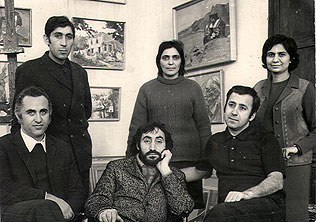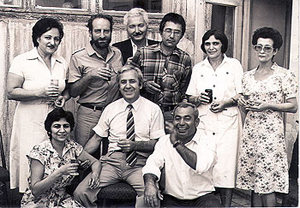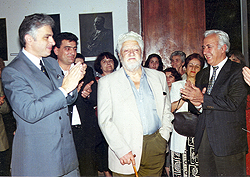The Museum / History
1991-2011 The National Gallery of Armenia

In 1991, the Republic of Armenia entered a new historical and political stage: the country declared independence. This event was significant because independence was something that the Armenian people had been fighting towards for centuries. But this decisive victory was accompanied by a number of problems forced by the newly formed republic, activities of which were reflected in the cultural life.The country entered a serious political, socio-economic, and cultural crisis. Along with the scientific and cultural establishments, the State Gallery of Armenia also had to bear many hardships during that time.
In 1991, the art historian Shahen Khachatrian was appointed the director of the Gallery. A person devoted to Armenian culture, previously collaborated with the Department of Armenian Fine Arts of the SGA, and since 1967 he had served the Director of the Martiros Sarian Museum. In 1991, Armenia’s largest artistic institution was renamed the National Gallery of Armenia (NGA).
In the same year, the Ministry of Culture of RA confirmed a new statute of the NGA. By uniting former Armenian old and medieval, new and modern art departments, one joint department of Armenian painting was established. Foreign and Russian painting departments were also created, becoming the Department of Foreign Painting.
Generally, the 1990’s were difficult times for the Gallery. Researchers did not have the opportunity to participate in conferences and training courses held in the former USSR’s largest maintaining centers. The connections with foreign museums and cultural establishments became difficult. However, even in difficult conditions, the staff of the National Gallery continued to carry out their duties. In 1992, the Gallery presented visitors with newly permanent and altered exhibitions, and during 1991-2000, about 130 exhibitions were organized. The museum’s various collections were presented, as well as personal exhibitions of differing contemporary artists. It is worth mentioning the highly successful exhibitions: “Three Coloured Worlds” (Martiros Sarian, Haroutiun Galentz and Minas Avetisian), as well as “Sea Song” held in Marseille (Hovhannes Aivazovsky and his followers).In this period of time when the obstacle of the “Iron Curtain” disappeared, the role of Diaspora’s Armenians in the NGA increased. The Gallery collection - the major part of which was created by means of donations – was continuously expanding, primarily because of the Armenians from the Diaspora.It was in those years that the National Gallery and the newly created “Sargis Khachents” publishing house began producing art literature that was translated from the originals into Armenian. The Gallery’s first trilingual guide was also published in France, as well as the albums of “Armenian Artists of the 19th-20th Centuries” and “Christian Armenia-1700”.
In 2002, painter and professor, Paravon Mirzoyan, was appointed the Director of the NGA. Under his supervision the Gallery’s research funds and educational departments flourished, giving the Gallery a new impact and field of opportunities. In the same year, the Ministry of Culture of RA issued an order stating that the “National Gallery of Armenia” was to be reorganized into a non-profit organization.
On May 18, 2004, after the reconstruction supported by the Lincy Foundation, the National Gallery of Armenia installed new permanent exhibitions and opened its doors to visitors. Since the reopening the Gallery has been leading an abundant working life - according to the principles of academic museum activity. That is to say to, collect, maintain, study and popularize artistic values by means of exhibitions and catalogues.

 A few exhibitions that were favored by the people were both the 125th anniversary of Georgi Yakoulov and the 150th anniversary of Vardges Sureniants. Presenting Armenian classical fine arts to foreign audiences is regularly undertaken by means of various international exhibitions. Exhibitions of international artists’ works have become more frequent. One of the most successful, perhaps, is considered the exhibition “Dali and the Surrealists” organized in 2011 by the Ministry of Culture of RA, which caused an exceptional response and interest among local Armenian art enthusiasts.
A few exhibitions that were favored by the people were both the 125th anniversary of Georgi Yakoulov and the 150th anniversary of Vardges Sureniants. Presenting Armenian classical fine arts to foreign audiences is regularly undertaken by means of various international exhibitions. Exhibitions of international artists’ works have become more frequent. One of the most successful, perhaps, is considered the exhibition “Dali and the Surrealists” organized in 2011 by the Ministry of Culture of RA, which caused an exceptional response and interest among local Armenian art enthusiasts.
In the last decade the publishing activity has greatly expanded. Each exhibition is the result of a research study of the presented collection, followed by the publishing of albums and catalogues. The NGA also plans on creating online catalogues, as well as publishing annual journals, where the studies by the Research -educational and Public Relations departments of the Gallery will be published.It is worth mentioning a few works the NGA has published: “The National Gallery of Armenia” (2008), albums of “Vardges Sureniants” (2010) and “Georgi Yakoulov” (2011) and monography of “Georgi Yakoulov” (2011).
.jpg) The museum expands its collection not only through public or private purchases, but also through donations, which has become the traditional custom of the NGA.
The museum expands its collection not only through public or private purchases, but also through donations, which has become the traditional custom of the NGA.
Since 2005, the annual “National Gallery” classical music festival has been organized in the museum, bringing together music and fine arts in the Frescoes hall of the Gallery. It is already the seventh year that the synthesis of art and music has been accessible to the Armenian audience.
The National Gallery of Armenia participates in a number of international programs. Since 2005 “Museums Night” international project has been implemented, this is already famous and favoured in large spheres of the society, as well as “The European Heritage Days” annually organized events.
In partnership with foreign embassies in our Republic, other countries’ cultural days are regularly held in the National Gallery.
Looking back at the history of the National Gallery of Armenia for the past ninety years, the NGA has established many culturally diverse missions, utilizing the museum to its fullest capabilities and substantiating its honor. The National Gallery will doubtlessly continue its devoted work to its nation and continuously develop and enrich it with new art, activities, and culture.
- 1921-1935 Art Department of the State Museum
- 1935-1947 The State Fine Art Museum
- 1947-1991 The State Gallery of Armenia
- 1991-2011 The National Gallery of Armenia